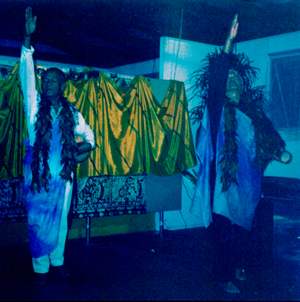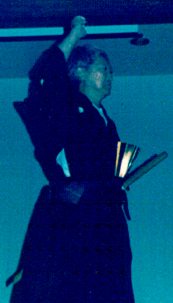BAFA © 2010. All material here is copyrighted. See conditions above. |
Robert Takashi Imagire
dancer, graphic artist, U.S.A. / the Cook Islands
|

Left to Right: Moki, DeeDee,
and Robert Imagire. They are performning at the Polynesian club in Reno, Nevada, U.S.A.
|
Decorative art and advertising art were my first interest. After attending the Fine Art School and the American Academy of Commercial Art in Chicago in the mid '40s, I ended up at the Malcomb Howard Advertising Agency as a commercial artist. I turned to fine arts, oils mainly, and went back to abstract painting. It was a way to get away from the realism required at the advertising agency, and to develop my interest in the abstract drawings I saw in the Chicago art galleries....
Another painting inspired by Florence Mayberry's poem was of a person on a spiritual quest, whose soul is torn apart when a White Bird of Heaven, representing a Messenger of God, opens the doors of truth.
"My soul was pulled apart like a frail wooden cart
by run away wild horses." ....
|
As a result of joining the Bahá'í community I answered the call to pioneer. I got a job with the US Government, working in a number of places around the world. Later I got a job at Berkeley City Hall in California. While there, I attended the Berkeley Senior Centre, where they had hula classes. I got into hula dancing, and later social dancing, because my doctor told me that my arthritis was caused by my sitting around too much. I drove to and from work sitting, did my work sitting, and did art work at home sitting. When I saw hula dancing at my friend's Hawai'ian shop, I thought it would be fun. And it cured me of arthritis.
Even though I am still an amateur when it comes to hula, I know more than to say, "yeah, I know hula", waving my arms and moving my hips in a circle. Now I know that it is just the hands that move, with the fingers moving like a fan opening and closing. Arms are held in a fixed position, elbows high like a ballerina's basic position. The hips move in a circle, hit four corners, or sway side to side, and the shoulders don't move. To get started, you hold your arms against the sides of a doorway to keep your shoulders still, and move your hips....
|

The hula, E Pele
Left to Right: Tangaroa, Pa Ariki, Queen of Muri Village and Robert Takashi Imagire.
|
Hawai'ian hula has basically two types: Kahiko and Auana. Unfortunately, most Americans think of the hula as a "hoochie koochie" dance seen at circus side shows. During Elvis Preseley's and Don Ho's time, the hula was shown as a romantic glamorous tropical dance. This is called Auana or "Hapa Hauli" (meaning half European). But the real hula is the ancient Kahiko, developed before the introduction of the guitar and ukulele. The instruments (called in Hawai'i "implements") used were drums ("Toeere"), bamboo sticks ("Pu'ili"), pebbles ("ili ili"), coconut shell halves ("nui"), feather gourds filled with seeds (like the Mexican "maracas") ("uli uli"), large hollowed-out gourds ("Ipu") and wooded sticks ("kala'au"). Like the belly dance, which was originally Hindu temple dancing, the hula stems from religious ceremonies. Like the Hindu dancing, the early Shinto dances of the Japanese, the dances of the Native Americans, and those of the whirling Dervishes of Iran, hula is a form of worship.
By learning the Kahiko, one begins to understand that the Hawai'ians (in fact all Polynesians) had a concept of the One Universal God, the Creative Force, with the Volcano, Ocean, Forest, and so on being emanations of this Force. I realized this when I learned my first Kahiko, "E Pele". When the missionaries asked the Hawai'ians if they believed in God, they were not able to answer because it was "tabu" (forbidden/sacred) to mention the name of God, God being beyond comprehension. The dance gesture for God is crossed arms at the wrist placed over the forehead and eyes, showing that God is beyond comprehension. But the Hawai'ians could speak of His Emanations, such as His Power, exemplified in the volcano. This Power was called "Pele". In "E Pele", the dancer/worshipers beseech the Power of God to protect them from that which is in front, behind, to the right and to the left, much like the Báb's prayer for protection. It is performed to chanting, the beat of the Heke (large ipu) and the smaller ipu.
|

The dance Kokee performed by Robert Takashi Imagire in 1991 at the Berkeley Buddhist Temple.
|
In the ancient days, the chief (Ariki) would stand near a large rock near a large tree, and pray for divine guidance, by tuning into the vibrations of the rocks and trees, absorbing the spiritual vibrations experienced for hundreds and thousand of years. This is much like the Native Americans heating the rocks at a sweat lodge to listen to the guidance of the rocks. "In that day, the rocks will shout", like the Burning Bush that spoke to Moses....
I had the honour of being invited to attend a sweat lodge, by my Choctaw Native American friend, Crazy Horse. The sweat lodge was located at the mass burial site of the Moyaone, Accokeek, Maryland, USA....
......The last chants were about the Twin Messengers from the East who will come and plant the Tree of Life, that it may grow green again. When it does, it will unite not only all the Native American tribes but all humanity. Then we all ran out of the mud hut and jumped into the cool refreshing waters of the Potomac River nearby. The next time I saw Crazy Horse, I told him how much water I was drinking - that I must have sweated a lot in the mud hut. Crazy Horse said, "I hope you also lost a lot of spiritual toxins as well."
From 1989 to 1991, I performed with the Berkeley Senior Citizen's hula group for seniors in convelescent homes, hospitals and clinics, as well as for birthday parties and social banquets.
|
During this time, the San Francisco Bahá'í LSA wanted me to bring the Chinese and Chinese Americans to the SF Bahá'í Centre. I found out that the Chinese about my age (then in my 60's) loved social dancing. So I had social dancing classes in the beautiful ballroom of the SF Bahá'í Center. These classes built up until at one time there were 32 Chinese couples attending. The classes taught Fox Trot, Waltz, Cha Cha, Rumba, and Tango. My hula partner and I took lessons in tap, Hungarian, and Irish dances. We put on a two-person show for the Bosch Bahá'í school's classes for the Elder Hosteler program on world religions, world peace, and the cultures of the world. We taught hula, and for the entertainment portion of the Elder Hosteler's graduation, we put on an intercultural show.....
Another group I brought to the SF Bahá'í Center was a Polynesian dance group. They were performing in the street in front of the Center in a city-wide celebration, and I was particularly impressed with their creativity. The leader (the kumu hula), Moki Hula Manu, chanted in Hawai'ian a Pe'e. I had always wanted to learn how to chant in the ancient Hawai'ian kahiko manner so I could chant Bahá'í prayers. During my enrolment with the Elder Hostel Program, I went five times to Honolulu and took courses on Hawai'ian art, dance, history and chanting....
|

Left to Right:
Robert Takashi Imagire and...
|
In July 1993, I moved to Aitutaki, an island in the Cook Islands. For five years, I had wanted to pioneer to Hawai'i, but the doors did not open. I went to the Cook Islands in October 1992 to look around and liked it better than Hawai'i because the Cook Islanders spoke their native language, ran their own government and owned all land. I also discovered that I would be able to live off my government retirement checks there. The Cook Island National Spiritual Assembly recommended that I go to one of the outer islands and not to the main island of Rarotonga, where jobs were more available. I chose Aitutaki because it had three places where they had "Island Night", an island food buffet with a Polynesian show. When I visited again in March 1993 to check out a place of residence, I was introduced to a Cook Island Maori couple who had just came back from performing in Japan for six months. When I got to their home, there on the front door were the names of the couple and their four children written in Japanese. We immediately became friends....
|
......Once there, I joined the dance group formed by the couple I had met previously. I taught Hawai'ian hula, and performed with the group for about two years. Then for three years we held an intercultural dance program at a hall that we rented. We performed Cook Island, Samoan, New Zealand Maori, Hawai'ian, and Japanese dance.
I performed a Japanese sword dance ("Kenbu") that I learned when I was 17 years old. Kenbu is almost as slow moving a dance as O-Noh, a very formal dance. Though I danced and moved ceremoniously slow, people wondered how I put so much energy into the dance. But it was not me; it was my mother's voice on the cassette tape, singing/chanting a cappelo in Shigin style, which is so energetic.
|

Robert Takashi Imagire.
|
The dance, "Benkei", is about a warring Buddhist Monk, who realized that force using the sword was not the solution to problems and swore not to use the sword again. After not using the sword for 10 years, one day when he returned home, he heard the screaming voice of his wife, who was tied to a tree and about to be slain by a thief. The Buddhist Monk, Benkei, killed the thief, but broke his vow not to use the sword. This kind of paradox is typical of Shigin in Haiku, five lines of alternating 5, 7, 5, 7. 5 syllables per line. The paradox here is that it is wrong to kill, but it is right to kill to protect a loved one, much like Bahá'u'lláh's teaching that one must not kill except to protect a loved one. I dressed in black kimono with a "hakama" (culotte). I must have danced with some energy and spirit because when I closed the fan that I was dancing with, slapping it on the palm of my left hand and causing a loud banging sound, and drew my sword to kill, it shocked most of the Cook Islanders in the audience....
...I am continuing to teach hula to the children who attend the Pan Pacific South East Asian Women's Association's "Telling Stories and Reading to Children" sessions at the College Library....
I've discovered I can do art work on my computer, so I'm back to redoing the illustrations on Florence Mayberry's poem...as well as making illustrations for "7 Steps To Problem Solving", based on Shoghi Effendi's "Dynamics of Prayer" (Malaysian printed White Bahá'í Prayer Book)....
How true are those words -- "Greater than the prayer is the spirit in which it is uttered, and greater than the way it is uttered is the spirit in which it is carried out."
Excerpts, Arts Dialogue, June 2000, pages 18 - 21
|

Arts Dialogue, Dintel 20, NL 7333 MC, Apeldoorn, The Netherlands
email: bafa@bahai-library.com
|
|

 The hula, E Pele
The hula, E Pele


